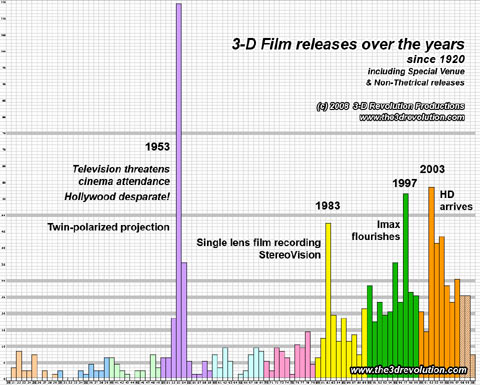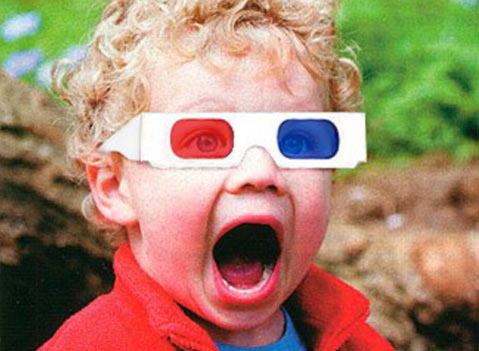

The 3-D Onslaught

Coraline was the first time I’d seen a film in 3-D in a very long time, and while I enjoyed the film immensely, the 3-D technology was a huge dud. The imagery on-screen was so fuzzy that I initially thought my glasses were defective and exchanged them for another pair. Apparently, it wasn’t the glasses though; that’s just part of the 3-D “experience”. Add to that an annoying strobe on close-up shots, tinted glasses that obscured details during the film’s darker scenes, and leaving the theater with a headache, and it ends up being a miserable experience that I don’t anticipate repeating anytime soon.
It’s too early to tell where 3-D will go, but every sign so far points to it being a corporate-induced fad just as it was in the 1950s. Having said that, I’m still fascinated by Hollywood’s shift to 3-D techology, particularly because animation now represents the second biggest category of 3-D releases, following documentary films. I’m also intrigued by the unique storytelling possibilities of the medium, though as yet I’m unclear as to what those may be. To that end, I’ve been searching for a solid source to learn more about the technology. I know there’s the MarketSaw blog which offers news about 3-D releases, but its uncritical cheerleading of every film doesn’t offer much insight into the art side of 3-D. Last night I finally stumbled across what I’ve been looking for–an amazing resource called 3-D Stereoscopic Film and Animation Blog which is run by a Bristol, UK-company called 3-D Revolution Productions.
Besides the informative blog, the company has all sorts of pages devoted to the technology such as 3-D film theory, how to build a 3-D camera, and an incredible piece of original research documenting every 3-D film ever released. In other words, if you’re at all interested in 3-D filmmaking, this blog and accompanying website is THE place to start your journey.
A chart that stood out on their blog is the one of 3-D releases throughout history. It’s surprising to see that 3-D never died out, and in fact, more 3-D films were released in the early-2000s than are being released today, though contemporary releases are obviously playing on a far greater number of screens:

There’s also an enlightening article that discusses the traditional 3-D effect of objects popping out at audiences–”negative parallax” is the technical term–and how the art of 3-D won’t develop until filmmakers move beyond these type of cheap tricks and recognize that:
“3-D movies are a different medium altogether — neither film nor theatre, but volumetric narrative visual entertainment of its own. A new medium with new rules — where the fourth wall can be broken at will and where serious drama is followed by visual puns and an opportunity to examine objects and scenery in volumetric detail.”
The author of the blog also shares this comment told to him in 2007 by Pixar director Pete Docter: “We have looked at 3-D in the past and have come to the conclusion that there is little to no way in which 3-D can indeed enhance the quality of our storytelling or enhance the character interaction in a meaningful way.” It leads to the question, What has changed in the past couple years that has convinced Pixar and other studios to create all their animated films in 3-D? Is it purely a response to market pressure and keeping up with Katzenberg, or have filmmakers found legitimate ways of using the technology to enhance storytelling? Perhaps I’ll discover the answer when I find a way to watch 3-D films without getting a migraine.

.png)